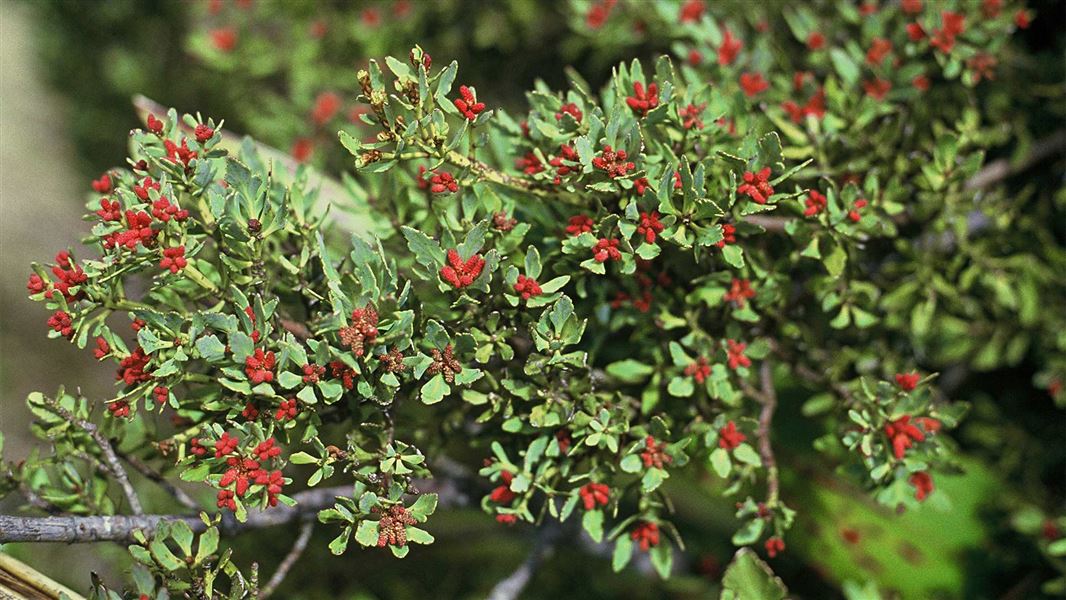
Introduction
Find out about native plants of Canterbury's sub-alpine areas.Grown from seed collected from the Mackenzie County Council District.
The sub-alpine region is dominated by various species of snow tussock, occupying a range of environmental conditions. The broad-leaved snow tussock (Chionochloa flavescens) and red tussock/hau mata (Chionochloa rubra) prefer wetter sites, where as the narrow-leaved snow tussock/wï kura (Chionochloa rigida) and the slim-leaved snow tussock (Chionochloa macra) prefer drier sites.
Shrub species are also common in the sub-alpine environment and form extensive communities, commonly referred to as a sub-alpine shrub zone. Snow tōtara (Podocarpus nivalis), mountain toatoa (Phyllocladus alpinus), porcupine shrub (Melicytus alpinus), species of turpentine shrubs (Dracophyllum), Hebes/koromiko, and Coprosma/karamū species are common throughout this area.
An important part of the sub-alpine flora is a wide diversity of herbaceous plant species. Common species include the mountain daisies (Celmisia/tikumu), speargrass/taramea (Aciphylla), small tussocks and grasses - such as mountain fescue (Festuca matthewsii) and carpet grass (Chionochloa australis), gentians and mountain buttercups/kawariki (Ranunculus). Mats, or cushion plants, designed to withstand harsh conditions, are also a feature of sub-alpine flora. Vegetable sheep, such as Raoulia exima, are an excellent example of the cushion plant habit.
Two threatened species found growing in the sub-alpine zone in Canterbury are Pittosporum patulum and Hebe cupressoides.
Species name and common name
T = threatened
- Acaena caesiiglauca
- Acaena inermis
- Aciphylla aurea taramea, golden spaniard
- Aciphylla montana
- Aciphylla scott-thomsonii
- Aciphylla subflabellata
- Aristotelia fruticosa mountain wineberry
- Brachyglottis bellidioides
- Brachyglottis bennetii
- Brachyglottis cassinioides
- Carmichaelia grandiflora
- Carmichaelia petriei desert broom
- Carmichaelia uniflora
- Celmisia semicordata false spaniard
- Chionochloa rigida wī kura, narrow leaved snow tussock
- Chionochloa rubra haumata, red tussock
- Coprosma atropurpurea
- Coprosma ciliata
- Chionochloa conspicua hunangāmoho
- Chionochloa flavescens broad leaved snow tussock
- Coprosma propinqua
- Coprosma ‘Taylorii’
- Coprosma rugosa
- Carmichaelia crassicaule
- Coriaria angustissima
- Coriaria sarmentosa
- Corokia cotoneaster korokio
- Craspedia uniflora woollyhead
- Discaria toumatu matagouri, tūmatakuru
- Festuca matthewsii alpine fescue tussock
- Festuca novae-zelandiae fescue tussock
- Hebe buchannii
- Hebe cupressoides
- Hebe haastii
- Hebe macrantha
- Hebe odora
- Hebe pinguifolia
- Hebe subalpina
- Melicytus alpinus porcupine shrub
- Muehlenbeckia axillaris
- Olearia cymbifolia shrub daisy
- Olearia fimbriata
- Olearia virgata
- Ozothamus leptophylla tauhinu, golden cottonwood
- Phyllocladus alpinus mountain toatoa
- Pimelea prostrata
- Pittosporum patulum (T)
- Poa colensoi blue tussock
- Poa macra
- Ranunculus lyallii
- Sophora microphylla kōwhai
- Sophora prostrata dwarf kōwhai